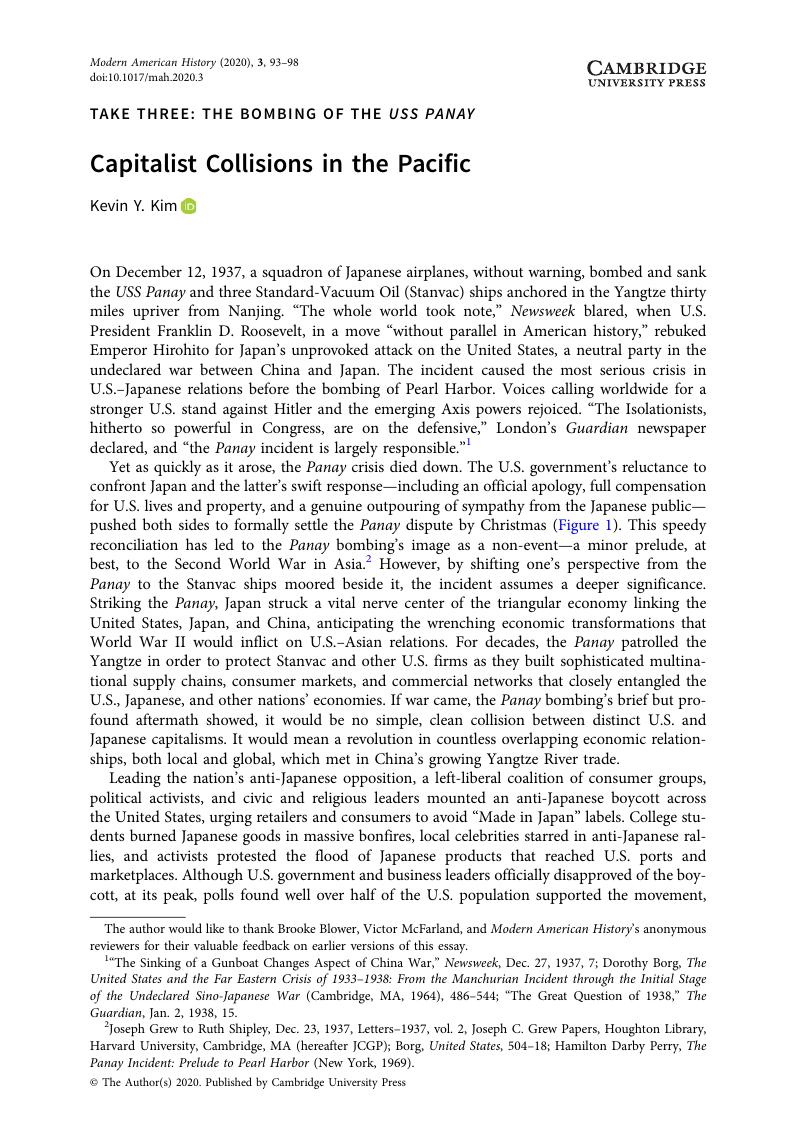No CrossRef data available.
Article contents
Capitalist Collisions in the Pacific
Published online by Cambridge University Press: 16 March 2020
Abstract

Keywords
Information
- Type
- Take Three: The Bombing of the USS Panay
- Information
- Copyright
- Copyright © The Author(s) 2020. Published by Cambridge University Press
Footnotes
The author would like to thank Brooke Blower, Victor McFarland, and Modern American History's anonymous reviewers for their valuable feedback on earlier versions of this essay.
References
1 “The Sinking of a Gunboat Changes Aspect of China War,” Newsweek, Dec. 27, 1937, 7; Borg, Dorothy, The United States and the Far Eastern Crisis of 1933–1938: From the Manchurian Incident through the Initial Stage of the Undeclared Sino-Japanese War (Cambridge, MA, 1964), 486–544CrossRefGoogle Scholar; “The Great Question of 1938,” The Guardian, Jan. 2, 1938, 15.
2 Joseph Grew to Ruth Shipley, Dec. 23, 1937, Letters–1937, vol. 2, Joseph C. Grew Papers, Houghton Library, Harvard University, Cambridge, MA (hereafter JCGP); Borg, United States, 504–18; Perry, Hamilton Darby, The Panay Incident: Prelude to Pearl Harbor (New York, 1969)Google Scholar.
3 “Revive Drive for Boycott of Japan Goods,” Women's Wear Daily, Dec. 20, 1937, 1; “Quarterly Survey,” Fortune, Apr. 1938, 109; Greater Boston Boycott Japanese Goods Committee, “Did Your Stockings Kill Babies? Yes, If—”, [1937], folder: Union Material, box 11, Florence Luscomb Papers, Schlesinger Library, Radcliffe Institute, Cambridge, MA.
4 “Hides Jap Name Plate,” The Lather, Aug. 1938, 14; National Research League, “Don't Buy Japanese Goods” [1938], folder: Japan, box 139, Jessie Lloyd O'Connor Papers, Smith College Special Collections, Northampton, MA; Angus McStay, “Sheer Symmetry,” Maclean's Magazine, Dec. 1, 1938, 24; B. J. Perkins, “Europe Still to Cash in on Anti-Japan Feeling,” Women's Wear Daily, Feb. 8, 1938, 8.
5 Glickman, Lawrence B., “‘Make Lisle the Style’: The Politics of Fashion in the Japanese Silk Boycott, 1937–1940,” Journal of Social History 38, no. 3 (Spring 2005): 582–3CrossRefGoogle Scholar; Becker, Nathan M., “The Anti-Japanese Boycott in the United States,” Far Eastern Survey 8, no. 5 (Mar. 1939): 49–55CrossRefGoogle Scholar.
6 “Reactions Vary in Congress on Panay Sinking,” New York Herald Tribune, Dec. 14, 1937, 4.
7 Anderson, Irvine H., The Standard-Vacuum Oil Company and United States East Asian Policy, 1933–1941 (Princeton, NJ, 1975), 3–108Google Scholar; Cochran, Sherman, Encountering Chinese Networks: Western, Japanese, and Chinese Corporations in China, 1880–1937 (Berkeley, CA, 2000), 12–42Google Scholar; Perry, The Panay Incident, 17.
8 “American Diplomacy Faces New Tests,” The Commercial and Financial Chronicle, Dec. 18, 1937, 3875; Masland, John W., “Commercial Influence upon American Far Eastern Policy, 1937–1941,” Pacific Historical Review 11, no. 3 (Sept. 1942): 293–4CrossRefGoogle Scholar; E. M. Van Voorhees, “Political and Economic Conditions in China and Japan,” Nov. 22, 1938, 16, folder 15, box 184, Thomas W. Lamont Papers, Baker Library, Harvard Business School, Cambridge, MA; “Forum of Executive Opinion,” Fortune, Sept. 1940, 114.
9 Wilkins, Mira and Hill, Frank Ernest, American Business Abroad: Ford on Six Continents (New York, 2011), 255CrossRefGoogle Scholar; Stephen Bell, “International High Lights,” Commerce and Finance, Dec. 25, 1937, 702; “An Editorial,” Commerce and Finance, Jan. 8, 1938, 8; Joseph Grew to Katsuji Debuchi, Dec. 19, 1938, Letters–1938, vol. 3, JCGP.

